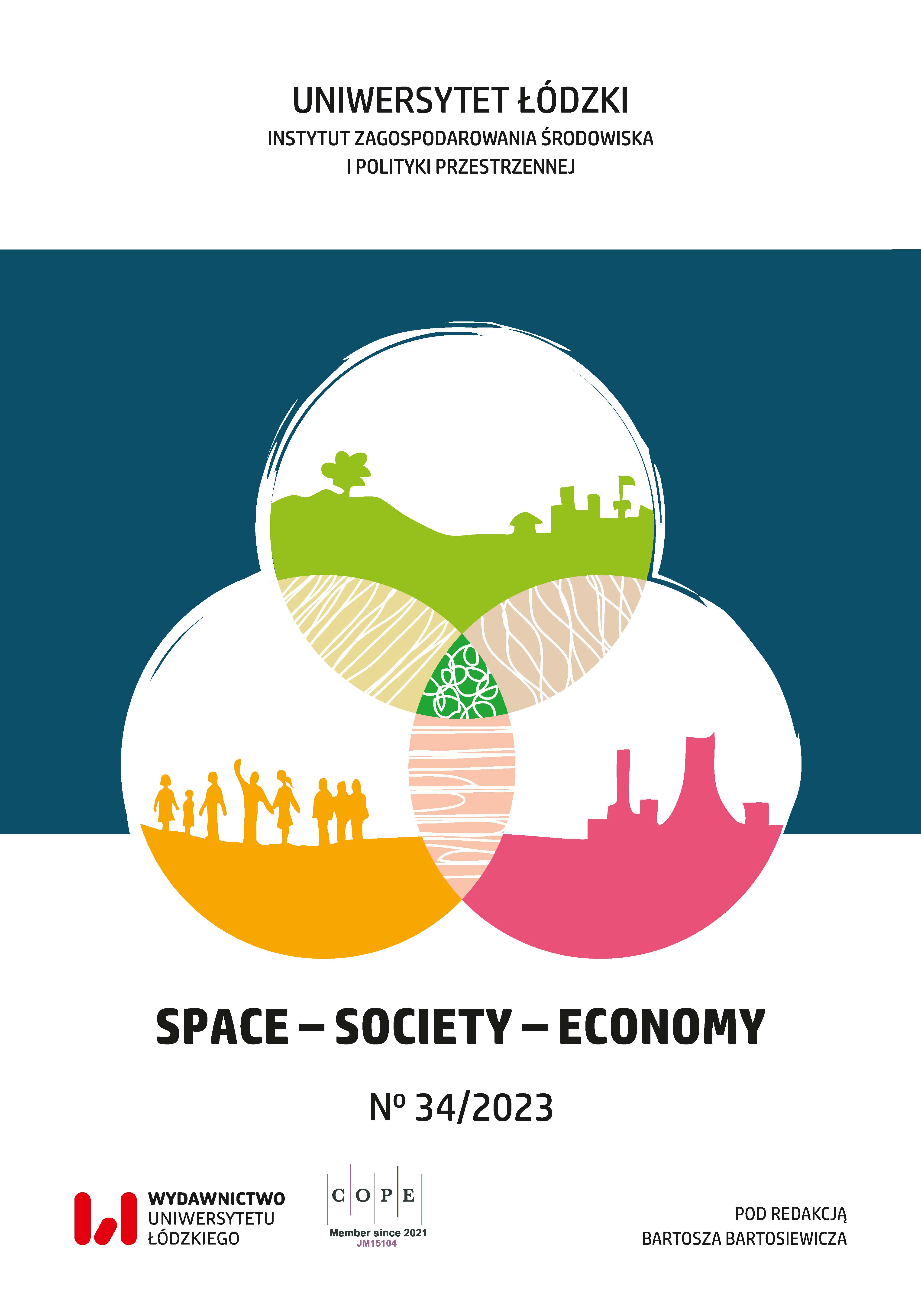Territorial dimension and spatial structure within development strategy for a local community, region or functional area
DOI:
https://doi.org/10.18778/1733-3180.34.01Keywords:
spatial development, spatial management, functional and spatial structure, spatial pattern, territorial dimension, strategy, local development strategy, regional development strategy, planning, spatial planning, urban planning, integrated planning, territorial development, urban development, local development, regional development, local development management, regional development management, local community, municipality, town, city, county, region, functional areaAbstract
This article deals with issues relating to the procedures for developing strategies for local communities, municipalities, and regions in the context of the contemporary postulates of a more integrated approach to development planning processes as well as taking into account the spatial dimension within territorially-oriented local and regional strategies. A concise discussion of the theoretical and formal premises of integrated planning in local communities and regions was made, paying attention in the first place to the fundamental differences in the functioning of private and public organisations, resulting in the necessity to adapt the instruments of strategic planning to the specific objectives of public sector organisations. It was also pointed out that municipalities, local or regional communities are public organisations of a very special nature (so-called “macro” level) and so a territorial self-government community is a kind of “organisation of other organisations”, i.e. a group of various entities related to each other by social relations and economic dependencies as well as sharing particular geographical area (land) and its natural and anthropogenic resources. It is this feature that implies the need to take into account the spatial dimension of development processes in the strategic planning of local and regional self-government entities, and thus also to appropriately address these issues in the strategic document. Such an approach – i.e. integrating the socio-economic dimension of development processes with the need to act for the protection of the natural environment and taking into account the spatial dimension of both development and protection activities – is also consistent with, and directly results from, the contemporary paradigm of sustainable development. With regard to the formal premises and practice of strategic planning of local and regional development, its evolution was indicated, consisting in the transition from directive planning (before 1989) to indicative planning, the use of local government strategies mainly as a tool for obtaining external financial resources (after Poland’s accession in 2004 to the European Union), adopting the legal basis for strategic development planning (2006), developing assumptions for the reform of the development planning system towards a more integrated approach (2009), up to the introduction (2020) of changes in the legal provisions regulating the methods of developing local and regional strategies, obliging local governments to include the spatial dimension in it. It was pointed out that despite the legislative changes of 2020, a dichotomous planning system still operates in Poland, in which a local or regional strategy is developed (albeit with spatial dimensions) and (based on separate regulations) master plans of the spatial pattern and land structure of a given local or regional territory. As from 2020, it became obligatory: 1) to include in the development strategies of local communities and regions the so-called model of the functional and spatial structure/pattern; 2) to formulate findings and recommendations in the field of managing spatial policy in the local community or region; as well as 3) to designate areas of strategic intervention. However, the legal regulations do not provide detailed guidelines on these issues, so it is reasonable to discuss the methodology of developing the model of the functional and spatial structure/pattern and its inclusion in the local or regional development strategy as its integral element. With this in mind, the article conceptualises the model of the functional and spatial structure/pattern as a spatial development that meets public interests and is to contribute to the growth of territorial capital. The essential part of the article is – apart from the explanation of the very essence of the model of the functional and spatial structure/pattern – the description of the author’s recommendations regarding what procedures which should be used when developing a local or regional strategy in order to develop the model of the functional and spatial structure/pattern of a local community, municipality or region on the basis of the local government development objectives set in the planning process, as well as adopted tasks and strategic projects. In the final part of the article, reference is made to the issue of formulating (based on the model of the functional and spatial structure/ pattern) arrangements and recommendations in the field of managing spatial policy in local or regional government, indicating in this respect the need to reform the spatial planning system, which ought to consist in the introduction of specialised spatial instruments.
Downloads
References
Camagni R., 2017a, Integrated Spatial Planning: Why and How?, [w:] R. Capello (red.), Seminal Studies in Regional and Urban Economics. Contributions from an Impressive Mind, Springer, Cham, https://doi.org/10.1007/978-3-319-57807-1
Google Scholar
DOI: https://doi.org/10.1007/978-3-319-57807-1
Camagni R., 2017b, Territorial Impact Assessment (TIA): A Methodological Proposal, [w:] R. Capello (red.), Seminal Studies in Regional and Urban Economics. Contributions from an Impressive Mind, Springer, Cham, https://doi.org/10.1007/978-3-319-57807-1
Google Scholar
DOI: https://doi.org/10.1007/978-3-319-57807-1_20
Drzazga D., 2012, Polityka przestrzenna i podejście terytorialne a koncepcja zrównoważonego rozwoju, „Handel Wewnętrzny”, 2: 30–38 („Trendy i wyzwania zrównoważonego rozwoju w XXI wieku. Zrównoważony rozwój na poziomie regionalnym. Zrównoważony rozwój na obszarach wiejskich”).
Google Scholar
Dziemianowicz W., Szmigiel-Rawska K., Nowicka P., Dąbrowska A., 2012, Planowanie strategiczne. Poradnik dla pracowników administracji publicznej, Ministerstwo Rozwoju Regionalnego, Departament Koordynacji Polityki Strukturalnej, Warszawa.
Google Scholar
Hoinkis D., Cieplak J., Machowski T., Odzimek W., Strategia rozwoju gminy. Poradnik praktyczny, 2021, Ministerstwo Funduszy i Polityki Regionalnej, Fundacja Rozwoju Demokracji Lokalnej im. Jerzego Regulskiego, FRDL Małopolski Instytut Samorządu Terytorialnego i Administracji z Krakowa, Warszawa.
Google Scholar
Kot J., 2003, Zarządzanie rozwojem gmin a praktyka planowania strategicznego, Wydawnictwo Uniwersytetu Łódzkiego, Łódź.
Google Scholar
Kudłacz T., Markowski T., 2018, The territorial capital of urban functional areas as a challenge for regional development policy: An outline of the concept, „Zarządzanie Publiczne”, 2(44): 41–55, https://doi.org/10.15678/ZP.2018.44.2.03
Google Scholar
DOI: https://doi.org/10.15678/ZP.2018.44.2.03
Markowski T. (red.), 2015, Zintegrowana strategia rozwoju warszawsko-łódzkiego obszaru funkcjonalnego do roku 2030 (projekt), Wydział Zarządzania Uniwersytetu Łódzkiego, Katedra Zarządzania Miastem i Regionem, Łódź.
Google Scholar
Markowski T., 2016, Kapitał terytorialny jako cel zintegrowanego planowania rozwoju, „MAZOWSZE Studia Regionalne”, 18/2016: 111–119, https://doi.org/10.21858/msr.18.08
Google Scholar
DOI: https://doi.org/10.21858/msr.18.08
Markowski T., 2019, Docelowy model struktury funkcjonalno-przestrzennej w zintegrowanym systemie dokumentów strategicznych, ekspertyza dla Ministerstwa Funduszy Strukturalnych i Rozwoju Regionalnego, maszynopis elektroniczny.
Google Scholar
Modele struktury funkcjonalno-przestrzennej w strategiach rozwoju, 2020, Ministerstwo Funduszy i Polityki Regionalnej, Departament Strategii, https://www.gov.pl/attachment/74aa7aa6-c366-45d6-8aa4-39abaaf90920
Google Scholar
Noworól A., 2013, Ku nowemu paradygmatowi planowania terytorialnego, CeDeWu, Warszawa.
Google Scholar
Sołtys J., 2008, Metody planowania strategicznego gmin z uwzględnieniem aspektów przestrzennych i rozwoju zrównoważonego, Wydawnictwo Politechniki Gdańskiej, Gdańsk.
Google Scholar
Sztando A., 2021, Wyzwania systemowej integracji zarządzania przestrzenią z zarządzaniem strategicznym rozwojem w wymiarach lokalnym, subregionalnym i regionalnym, „Samorząd Terytorialny”, 12/2021: 19–33.
Google Scholar
Sztando A., 2022, Czy modele oraz ustalenia i rekomendacje prawidłowo integrują zarządzanie przestrzenią z zarządzaniem strategicznym rozwojem gmin? Potrzebne korekty przepisów i działania edukacyjne, „Samorząd Terytorialny”, 12/2022: 7–23.
Google Scholar
Turała M., Markowski T. (red.), 2015, Planowanie jako instrument zintegrowanego zarządzania w jednostkach samorządu terytorialnego. Podręcznik dla samorządowców dotyczący innowacji, Katedra Zarządzania Miastem i Regionem, Wydział Zarządzania Uniwersytetu Łódzkiego, wyd. 1, Łódź.
Google Scholar
Zaucha J., Brodzicki T., Ciołek D., Komornicki T., Mogiła Z., Szlachta J., Zaleski J., 2015, Terytorialny wymiar wzrostu i rozwoju, Difin, Warszawa.
Google Scholar
Żuber P., 2011, Terytorialny wymiar w polityce rozwoju – potrzeba zmian systemowych w świetle nowej generacji dokumentów planistycznych, [w:] T. Markowski, P. Żuber (red.), System planowania przestrzennego i jego rola w strategicznym zarządzaniu rozwojem kraju, „Studia Komitetu Przestrzennego Zagospodarowania Kraju Polskiej Akademii Nauk”, 134: 7–24.
Google Scholar
Ustawa z dnia 27 marca 2003 r. o planowaniu i zagospodarowaniu przestrzennym (Dz.U. 2003 nr 80 poz. 717 z późn. zm.).
Google Scholar
Ustawa z dnia 8 marca 1990 r. o samorządzie gminnym (Dz.U. z 1990 r. nr 16 poz. 95 z późn. zm.).
Google Scholar
Ustawa z dnia 5 czerwca 1998 r. o samorządzie powiatowym (Dz.U. z 1998 r. nr 91 poz. 578 z późn. zm.).
Google Scholar
Ustawa z dnia 8 marca 1990 r. o samorządzie terytorialnym (Dz. U. z 1990 r. nr 16 poz. 95).
Google Scholar
Ustawa z dnia 5 czerwca 1998 r. o samorządzie województwa (Dz.U. z 1998 r. nr 91 poz. 576 z późn. zm.).
Google Scholar
Ustawa z dnia 6 grudnia 2006 r. o zasadach prowadzenia polityki rozwoju (Dz.U. z 2006 r. nr 227 poz. 1658 z późn. zm.).
Google Scholar
Ustawa z dnia 24 stycznia 2014 r. o zmianie ustawy o zasadach prowadzenia polityki rozwoju oraz niektórych innych ustaw (Dz.U. z 2014 r. poz. 379).
Google Scholar
Ustawa z dnia 15 lipca 2020 r. o zmianie ustawy o zasadach prowadzenia polityki rozwoju oraz niektórych innych ustaw (Dz.U. z 2020 r. poz. 1378).
Google Scholar
Downloads
Published
How to Cite
Issue
Section
License

This work is licensed under a Creative Commons Attribution-NonCommercial-NoDerivatives 4.0 International License.









